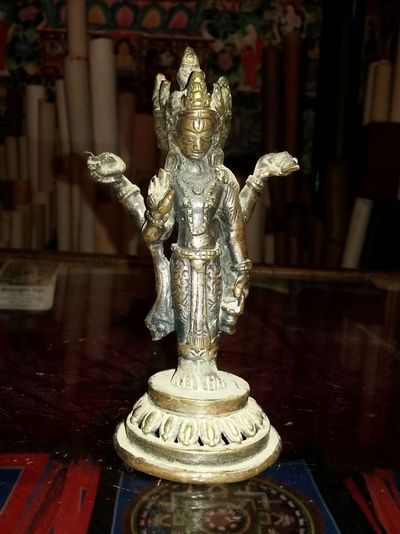Loading Content..

Brahma is the creator god in the Trimurti of Hinduism. He has four faces, looking in the four directions. Brahma is also known as Svayambhu Vagisa (Lord of Speech), and the creator of the four Vedas, one from each of his mouths. Brahma is identified with the Vedic god Prajapati, as well as linked to Kama and Hiranyagarbha (the cosmic egg), he is more prominently mentioned in the post-Vedic Hindu epics and the mythologies in the Puranas. In the epics, he is conflated with Purusha. Brahma, along with Vishnu and Shiva, is part of a Hindu Trinity, however, ancient Hindu texts mention other trinities of gods or goddesses which does not include Brahma.
Brahma is often credited as the creator of the universe and various beings in it, several Puranas describe him being born from a lotus emerging from the navel of the god Vishnu. Other Puranas suggest that he is born from Shiva or his aspects, or he is a supreme god in diverse versions of Hindu mythology. Brahma, along with Vishnu and Shiva, is also viewed as a different form of Brahman, the ultimate formless metaphysical reality and cosmic soul in Hinduism.
Brahma is traditionally depicted with four faces and four arms. Each face of his points to a cardinal direction. His hands hold no weapons, rather symbols of knowledge and creation. In one hand he holds the sacred texts of Vedas, in second he holds mala (rosary beads) symbolizing time, in third he holds a ladle symbolizing means to feed sacrificial fire, and in fourth a utensil with water symbolizing the means where all creation emanates from. His four mouths are credited with creating the four Vedas. He is often depicted with a white beard, implying his sage like experience. He sits on lotus, dressed in white (or red, pink), with his vehicle (vahana) â hansa, a swan or goose â nearby.
Chapter 51 of Manasara-Silpasastra, an ancient design manual in Sanskrit for making Murti and temples, states that Brahma statue should be golden in color. The text recommends that the statue have four faces and four arms, have jata-mukuta-mandita (matted hair of an ascetic), and wear a diadem (crown). Two of his hands should be in refuge granting and gift giving mudra, while he should be shown with kundika (water pot), akshamala (rosary), a small and a large sruk-sruva (laddles used in yajna ceremonies). The text details the different proportions of the murti, describes the ornaments, and suggests that the idol wear chira (bark strip) as lower garment, and either be alone or be accompanied with goddesses Sarasvati on his right and Savitri on his left.
Brahma's consort is the goddess Saraswati. She is considered to be "the embodiment of his power, the instrument of creation and the energy that drives his actions".
The origins of Brahma are uncertain, in part because several related words such as one for Ultimate Reality (Brahman), and priest (Brahmin) are found in the Vedic literature. The existence of a distinct deity named Brahma is evidenced in late Vedic text. A distinction between spiritual concept of Brahman, and deity Brahma, is that the former is gender neutral abstract metaphysical concept in Hinduism, while the latter is one of the many masculine gods in Hindu mythology. The spiritual concept of Brahman is far older, and some scholars suggest deity Brahma may have emerged as a personal conception and visible icon of the impersonal universal principle called Brahman.
Though almost all Hindu religious rites involve prayer to Brahma, very few temples are dedicated to His worship. Among the most prominent is Brahma Temple, Pushkar. Once a year, on Kartik Poornima, the full moon night of the Hindu lunar month of Kartik (October â November), a religious festival is held in Brahma's honour. Thousands of pilgrims come to bathe in the holy Pushkar Lake adjacent to the temple. There is a temple in Asotra village in Balotra taluka of Rajasthan's Barmer district, which is known as Kheteshwar Brahmadham Tirtha.
Temples to Brahma also exist in Tirunavaya in Kerala. The Trimurti temple and the temple dedicated to Brahma accompanied by Ganesha, located outside Padmanabhaswamy Temple in Thiruvananthapuram, Kerala, is also famous. He is also a part of the Trimurti in Thripaya Trimurti Temple and Mithrananthapuram Trimurti Temple in Kerala. Regular pujas are held for Brahma at the temple in Tirunavaya, and during Navratris, this temple comes to life with multi-varied festivities.
Also in the temple town of Kumbakonam in the Thanjavur District of Tamil Nadu and in Kodumudi in the Erode District of Tamil Nadu. There is also a shrine for Brahma within the Brahmapureeswarar Temple in Tiruchirappalli.
There is a temple dedicated to Brahma in the temple town of Srikalahasti near Tirupati, Andhra Pradesh.
7 feet height of Chatrumukha (Four Faces) BRAHMA temple at Bangalore, Karnataka.In the coastal state of Goa, a shrine belonging to the fifth century, in the small and remote village of Carambolim in the Sattari Taluka in the northeast region of the state is found. Famous murti of Brahma exists at Mangalwedha, 52 km from the Solapur district of Maharashtra and in Sopara near Mumbai. Statues of Brahma may be found in Khedbrahma, Gujarat.
Loading..
Please wait for the page to fully load for optimal functionality.
Loading Content..